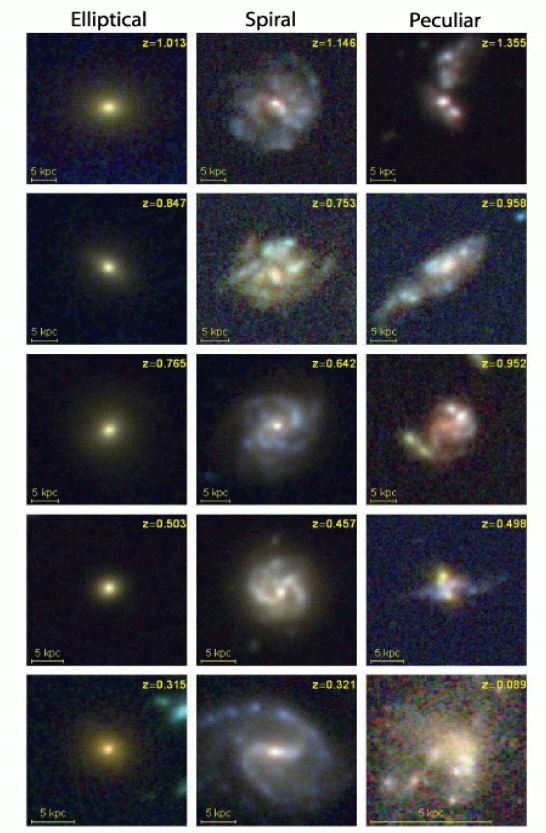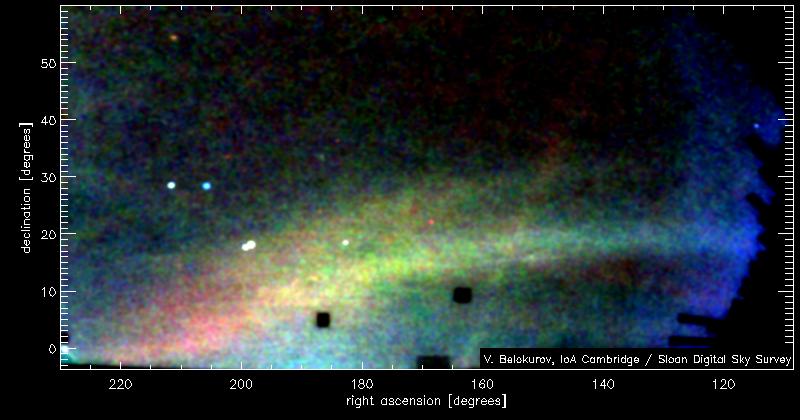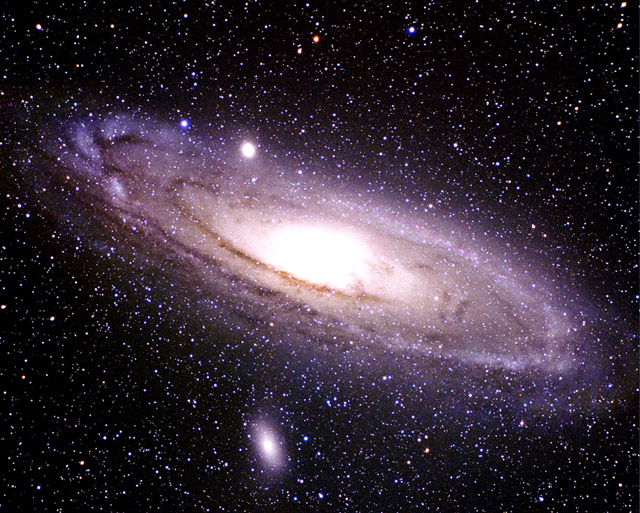
Today we will take a closer look at ideas for why there are different types of galaxies. We will end our discussion by talking about some of the more unusual types of galaxies. Before we start, we must re-introduce the notion of light travel time. Remember that the speed of light (300,000 km/s) is the fastest velocity at which information can pass in our Universe. The average distance to the Moon is 384,000 km. Thus, light takes 1.28 seconds to travel from the Earth to the Moon (or vice versa). If you have been watching the news coverage of the revolutions in the Middle East, you will notice that there are delays in the conversation when someone in New York (or Atlanta, or Washington) is talking to someone in Libya or elsewhere in the Middle East. This is due to light travel time. To communicate around our globe, various governments and corporations have communication satellites in geosynchronous orbit around the Earth. A geosynchronous orbit is special in that a satellite at this distance from Earth (about 33,000 km) stays "stationary" over the same location above the Earth's equator. What is happening is that the orbital period of the satellite is 24 hours, the same as the Earth's rotation rate. Thus, the satellite appears to remain fixed over the same spot on the Earth's surface.
When a news anchor is in this country and talking to someone in Egypt, their voice must first travel to a satellite dish, get beamed to the satellite, get beamed back down to Earth, and then relayed to the correspondent. The travel time to and from a geosynchronous satellite totals about 0.25 sec. Add in the other parts of the travel, and the possibility of more than one trip to a satellite means that there can be a significant delay between the anchor asking a question, and the reporter answering the question. You are witnessing the speed of light in action. It is finite, so there is a definite lag in communication between distant locations.
The same speed limit is at work in astronomy. It is not too much of a concern in the local neighborhood, but becomes extremely important as we move out to examine the rest of the Universe. For example, the light from the Sun takes about 8 minutes to reach Earth, while light, including radio signals, sent from Jupiter take about 32 minutes to get here. To send signals to/from Pluto would take more than 5 hours!
The nearest star to the Sun, Alpha Centauri, is at a distance of 4.3 light years. It has taken light 4.3 years to make its journey from Alpha Centauri to Earth. When you look at the constellation of Orion, you are looking back in time about 700 to 1500 years---most of the bright stars in Orion are at a distance of about 700 to 1500 light years, so the light reaching your eyes that was emitted by the red supergiant Betelgeuse started its journey around the year 1300. Fortunately, light ages well, and it hasn't changed in the intervening years! The most distant stars that you can see with your naked eye are a few thousand light years away--when light left those stars, the Roman Empire was still dominating southern Europe and the Middle East.
In a dark sky, away from the city, it is possible to even see further. For example, during the fall and winter months, you can see the "Double Cluster' in Perseus in the northeast (see the constellation highlight in your lab book for December). The combined light of several thousands stars allows us to see this object even though it is 7,500 light years from Earth. When this light left those clusters, writing had not yet been developed in ancient Sumeria (modern day Iraq). Some globular clusters are even more distant, and still visible to the naked eye. Because globular clusters contain more than one hundred thousand stars, we can see them at distances of 30,000 light years. Light from these globular clusters started its journey back when the Earth was still in the grips of the last ice age.
But we are not quite done yet. In the Autumn, there is a faint, fuzzy patch in the constellation of Andromeda that has been known about for at least a thousand years---the Andromeda galaxy. We talked about this object in the previous set of notes, it is an Sb galaxy that is the nearest large spiral galaxy to the Milky Way--our nearest big neighbor. The Andromeda galaxy is at a distance of 0.7 Mpc, or 2,280,000 light years! When the light that is now reaching your eyes left the stars in the Andromeda galaxy, the first ancestors of modern humans were roaming the plains of Africa. When we look at distant objects we are looking back in time--the further away the object, the longer the time its light has spent traveling to us. Thus, we are always seeing astronomical objects as they were, at a time when their light started its journey to the Earth.
While this causes a large number of problems, it also gives us some advantages. For example, if we want to see how galaxies formed, all we have to do is look at very distant objects--we are looking back to a time when some of these objects were at the initial stages of formation. We can actually see how galaxies formed. The only problem is that we see snapshots of formation--an image of a galaxy at one instant in its history. Thus, we will have to use a lot of detective work to try to figure out why some galaxies are spirals, and some galaxies are ellipticals.
Let's refresh ourselves about the main types of galaxies: spirals, ellipticals and irregulars. For the moment, lets ignore the irregulars. The largest galaxies in the Universe are giant elliptical galaxies (such as M87 shown in the notes for the last class). Giant ellipticals are about 10X more massive than the largest spiral galaxies. It is interesting that the smallest galaxies in the Universe are also elliptical galaxies--they are called "dwarf spheroidal" galaxies. The smallest dwarf spheroidal galaxies have about the same number of stars as the largest globular clusters, a million stars or so. Here is what one of these objects looks like:

This object is called the "Fornax Dwarf Spheroidal" galaxy, and it is actually one of the larger of these kinds of objects, as it has two globular clusters (the two brightest "stars" near the center of this photograph). Why do elliptical galaxies span such a large range? The largest giant elliptical galaxies are more than a million times more massive (1013 MSun) than the smallest dwarf spheroidal galaxies (107 MSun). Spiral galaxies, on the other hand, do not span such a large range in mass. The largest spiral galaxies have masses of 5 x 1012 MSun, while the smallest spirals have masses of 1 x 1010 MSun. Spirals only exhibit a range of about 500 in size from the largest to the smallest.
The following figure summarizes much about how galaxies appear at different ages:

This is like taking a snapshots of people at different ages and trying to figure out how the grow and change, as assembled here. Here is an image showing what distant galaxies look like (top), and how they change with time (bottom):

Whatever process creates spiral galaxies cannot work if they are too massive, or if they do not have enough mass. This is an important clue, but one whose meaning we do not yet understand. Right now, a debate rages why there are elliptical galaxies and why there are spirals. One idea is that galaxies are like they are because of the initial conditions in the "proto-galactic" cloud from which they formed. If the cloud was slowly rotating, as it collapsed it would form a disk (see the class notes for Class 21), just as we described in the formation process of our solar system. This disk would then lead to the formation of spiral arms as the disk rotated. Elliptical galaxies, on the other hand, collapsed from gas that was not rotating:

One problem with this scenario is that it cannot explain why there is no star formation currently occuring in most elliptical galaxies. There is no obvious process in this scenario that can explain why ellipticals have only old stars, while spirals continue to produce new stars.
The second idea about why there are two main types of galaxies centers around the idea that elliptical galaxies formed from denser proto-galactic clouds than spirals. The higher density means that the cloud collapses more quickly, and all of the stars form at once:

This idea explains why ellipticals have old stars, and why the bulges of spirals are also made up of old stars---the highest density regions collapsed to form stars first, and thus they are full of old stars. But this scenario doesn't really address how the collapse rate of a cloud determines whether or not a disk will be formed. It is likely that a combination of these two scenarios actually explains some of the reasons galaxies differ--the initial density and rotation rate of the cloud governs the nature of the galaxy that is formed.
During the last few years, we have realized that there is another very important process that occurs among galaxies that certainly influences their structure and nature: interactions or collisions with other galaxies. While the Universe is mostly empty, galaxies themselves seem to come in small groups, or in larger groups called clusters. For example, the Milky Way galaxy and the Andromeda galaxy are the two main galaxies in a group of about 25 galaxies we call the "Local Group":


Most of the galaxies in the Local Group are small elliptical galaxies, or dwarf spheroidals. The largest three galaxies are spirals (the Milky Way, Andromeda, and M33). Most of the smaller galaxies are in close orbits around either Andromeda or the Milky Way. For example, the Magellanic clouds (visible from the southern hemisphere) are two rather large irregular galaxies that orbit the Milky Way. They are located at a distance of about 120,000 ly. Note that our galaxy has a radius of about 50,000 ly, so these galaxies are very close to the edges of the Milky Way. In the last class, you saw examples of two elliptical galaxies that are very close-in to the disk of the Andromeda galaxy.
Over time, the orbits of these small, companion galaxies can carry them close to a big galaxy--if they get too close, they can be disrupted, or completely destroyed. Right now the Milky Way is in the process of consuming a small galaxy called the Sagittarius dwarf elliptical. Recently, with the SDSS survey (that is sited near Cloudcroft, NM), we have uncovered a number of "star streams" which are stars that have been ripped from these small galaxies as they are consumed by the Milky Way:

These small dwarf galaxies can often have a lot of gas associated with them since the lower density gas means the stars have formed more slowly. Thus, the collision of a gas-rich dwarf galaxy with a larger object can add new gas to the more massive galaxy, and this gas can form stars. Thus, if an elliptical galaxy ate a gas-rich dwarf galaxy, it could have a disk of stars form around it! Galaxy collisions are quite common, here are two spirals (knicknamed the "Antennae") that are in the process of merging to form one larger galaxy:

Note all of the young blue stars, and the clusters of stars. Collisions of two galaxies usually produces lots of young stars and HII regions as the gas clouds ram together, triggering cloud collapses, and the formation of lots of young stars and HII regions. With modern computers, we can now simulate the process, and speed it up so we can see what happens when two galaxies collide (figure 21.10):

Galaxy collision simulation movie (Mpeg galaxy collision simulation website). Another galaxy collision movie.
In the preceding examples, two spirals merged together to form an elliptical galaxy. We do not yet know if this is a reasonable scenario or not, but we certainly know that galaxies are continuing to interact, and these interactions may shape much of what we see. For example, one common type of galaxy in the Universe seems to represent the end product of two merging galaxies: a "starburst galaxy". Starburst galaxies resemble enormous HII regions--they appear to be nothing but one big mass of young stars and the gas and dust from which they are forming:


We believe that starburst galaxies form when two gas-rich galaxies collide, or when they pass close-by each other and interact. The collision of the gas clouds causes the star formation to be very rapid. As we look to the most distant galaxies, back to the early days of our Universe, we find that there are many more starburst galaxies. This tells us that the merging of galaxies was much more common in the past, and it shows that we must take this process into account when we are trying to understand the galaxy formation process.
Other times it looks like a spiral is merging with an elliptical:

Clearly galaxy mergers are very important, just how important remains unknown. Some believe that all elliptical galaxies actually formed from spiral galaxies early on through mergers:

Formation of the Milky Way, a simulation. Showing how our galaxy grew by eating up smaller objects. This is surely how all bigger galaxies grow.
The end result for the lower density regions (like our Local Group) is that more large spiral galaxies are formed than large ellipticals. It remains hard to actually find the smallest dwarf spheroidals and irregulars because they are faint, and difficult to detect--more are being found, but the search continues. As we will see in the next lecture, very few spiral galaxies are found in dense galaxy clusters, and a large fraction of all galaxies in the Universe are found in clusters.
In the Local Group, there are two dominate galaxies, the Milky Way, and Andromeda. Since the definition of the Local Group is that we are loosely bound together like an open cluster of stars, these galaxies interact gravitationally. The future for the Local Group is interesting! For example, in about 4 billion years, the Milky Way and Andromeda,


will collide and eventually merge together into a single, massive galaxy.
There are several other types of galactic objects in our Universe that are related to normal galaxies, but are somewhat more exotic. These are apparently normal galaxies, but ones where there is a supermassive black hole at the center of the galaxy that is consuming a large amount of matter. Just about all large galaxies probably have supermassive black holes at their centers. We know the Milky Way does, as does Andromeda. But in the case of the Milky Way and Andromeda, very little activity is currently occurring around their central black holes. This is not the case elsewhere in the Universe. Some galaxies have extremely active central regions--or "active nuclei"--where the central black hole is sucking-in nearby gas, dust, and stars. These regions get very hot, and emit all forms of electromagnetic energy from high energy gamma-rays all the way down to the radio:

One example is the giant elliptical galaxy, M87, which has a high velocity "jet" of material streaming out of the nucleus at nearly the speed of light:

The most extreme example of active galactic nuclei are the "quasars". Quasar is short for Quasi-Stellar object. In most telescopes, quasars look like faint stars--the "host" galaxy is much fainter than the active nucleus that outshines it. But using the Hubble Space Telescope, we can now see the underlying galaxies, and here is an example (Fig. 20.17):

The quasar is the bright star-like object in this photograph and is the bright nucleus of the galaxy, the place where the supermassive black hole is accreting material from its surroundings. The luminosity generated by the black hole is much higher than all of the other stars in the galaxy. Note that the underlying galaxy hosting the quasar seems to be disturbed, as if it had recently undergone a galaxy-galaxy merger. This may be how quasars are formed, two galaxies collide, and either a black hole is created by the collision, or a pre-existing black hole is flooded by gas, dust, and stars that results from the collision of the densest regions of the two galaxies. All of this material pouring into the black hole creates an accretion disk, and this is the source of a quasar's luminosity (Figure 21.24):

Here is an real (radio) image of a galaxy showing large jets and hot outflowing gas:

Quasars are the most luminous objects in the Universe--they outshine normal galaxies by a factor of 1,000 or more! Because they are so luminous, we can see them at further distances than any other object. When we compare how many quasars there were in the distant times with more recent times, we find that most quasars existed a long time ago, and have died out since the earliest days:

Whatever process that triggers the formation of a quasar has declined in recent epochs. Since galaxies were closer together in the early days of the Universe, it is likely that galaxy collisions are responsible for the formation of quasars, and as galaxies get further apart in the expanding universe (next lectures), fewer big mergers take place.
